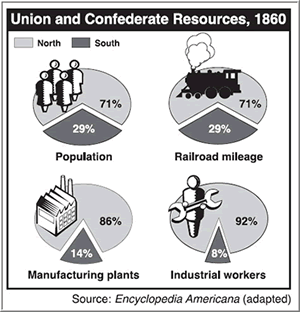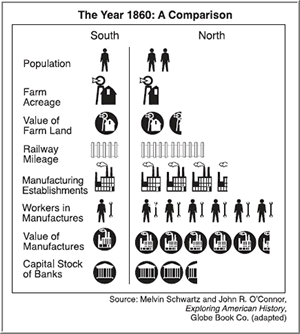
Content Partner
Grades 3-5

Don't have an account yet? Sign up for free
Don't have an account yet? Sign up for free


The North won the Civil War in large part due to its superior resources. In this lesson students will learn the difference between capital resources, human capital, and natural resources. They will investigate and compare the resources held by the North and the South during the Civil War. They will classify the resources and make a value judgment as to which resources were the most important in the war.
[NOTE: In order to benefit from this lesson, your students should be somewhat familiar with the terms capital resources, human capital, and natural resources. Before beginning the lesson, do a quick review of the terms as necessary.
The students will follow the websites provided to determine how the South’s resources compared to the North’s]
After reading about the different types of resources each side had and classifying them, the students will make a value judgment as to which resource was the most important. You could extend the lesson by having a class debate on whether the South would have won the war had the resources been equal.
You can read the student introduction aloud or allow the students to begin on their own. What resources did the South have at the time of the Civil War, and how did they compare to the North’s resources? Did the difference in resources have an impact on the outcome of the war?
Activity One
[NOTE: Provide an overview of the lesson:]
The Civil War as in many ways was a war of resources. In your study of the Civil War and its causes, you should stop to take a look at the types of resources each side had and how the distribution of resources affected the outcome of the war.
Introduce these concepts: capital resources, human capital, and natural resources. In the first activity the students will read about capital resources, human capital, and natural resources and see an illustration of each.
 |
Capital Resources: Resources made and used to produce and distribute goods and services; examples include tools, machinery and buildings. |
 |
Human Capital: The health, education, experience, training, skills and values of people. It is also known as human resources. |
 |
Natural Resources: "Gifts of nature" that can be used to produce goods and services; for example, oceans, air, mineral deposits, virgin forests and actual fields of land. When investments are made to improve fields of land or other natural resources, those resources become, in part, capital resources. Also known as land. |
Students will then be asked to classify each in their own words in the open response shown below.
Activity Two
Now that the students understand the different types of resources in the world, they are going to look at the resources that the North and South had available to them at the time of the Civil War.
 |
| Chart from Greece Central School District |
 |
| Chart from Greece Central School District |
Activity Three
The students will now do a little more research about the capital, human, and natural resources of the North and South. They will pick one category (capital, human, or natural) and specifically compare the North to the South. They will need to take notes on their own paper and then write two to three paragraphs about the comparison. They can use the charts above and websites below to gather information.
Recap the lesson by asking the students to give their own definitions of capital resources, human capital, and natural resources. You could have physical items or pictures available and hold them up, asking the students to classify the new examples.
Then ask the students which side they would choose to fight on (North or South) based on the resources available.
1. Have the students write a five paragraph essay entitled "The Civil War: A War of Resources." The first paragraph should be the introduction; the second, third, & fourth paragraphs should address the categories; and the fifth paragraph should be the conclusion.
2. Have the students make a poster or powerpoint presentation about one of the resource categories, using information from the websites above.
3. Have the students discuss and answer the following questions:
The students will be able to access this interactive link to answer and print the questions.
[Answers will vary.]
[Answers will vary.]
[Answers will vary.]
Bring the students back together to discuss different ideas as a whole class and have them write a short reflection paper over the questions.
The students will synthesize what they have learned about the North's and the South's resources. They will demonstrate what they have learned by writing a two to three paragraph description of one of the categories (capital, human, or natural) and compare the North to the South by reference to that category. They will take notes on their own paper and then write the paragraphs in the space provided. They should include in the first paragraph a definition of the category you are writing about. They need to compare at least three items within that category.
The students will then make a value judgment by answering the following question. Which category (capital, human, or natural) do you think was most important in allowing the North to win the war? Explain why. Both questions will be shown in the open response below.

Content Partner
Grades 3-5

Grades K-2, 3-5

Grades K-2, 3-5

Grades K-2
